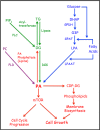Phospholipase D and the maintenance of phosphatidic acid levels for regulation of mammalian target of rapamycin (mTOR)
- PMID: 24990952
- PMCID: PMC4132766
- DOI: 10.1074/jbc.R114.566091
Phospholipase D and the maintenance of phosphatidic acid levels for regulation of mammalian target of rapamycin (mTOR)
Abstract
Phosphatidic acid (PA) is a critical metabolite at the heart of membrane phospholipid biosynthesis. However, PA also serves as a critical lipid second messenger that regulates several proteins implicated in the control of cell cycle progression and cell growth. Three major metabolic pathways generate PA: phospholipase D (PLD), diacylglycerol kinase (DGK), and lysophosphatidic acid acyltransferase (LPAAT). The LPAAT pathway is integral to de novo membrane phospholipid biosynthesis, whereas the PLD and DGK pathways are activated in response to growth factors and stress. The PLD pathway is also responsive to nutrients. A key target for the lipid second messenger function of PA is mTOR, the mammalian/mechanistic target of rapamycin, which integrates both nutrient and growth factor signals to control cell growth and proliferation. Although PLD has been widely implicated in the generation of PA needed for mTOR activation, it is becoming clear that PA generated via the LPAAT and DGK pathways is also involved in the regulation of mTOR. In this minireview, we highlight the coordinated maintenance of intracellular PA levels that regulate mTOR signals stimulated by growth factors and nutrients, including amino acids, lipids, glucose, and Gln. Emerging evidence indicates compensatory increases in one source of PA when another source is compromised, highlighting the importance of being able to adapt to stressful conditions that interfere with PA production. The regulation of PA levels has important implications for cancer cells that depend on PA and mTOR activity for survival.
Keywords: Diacylglycerol Kinase; Lipid Metabolism; Lysophosphatidic Acid Acyltransferase; Mammalian Target of Rapamycin (mTOR); Phosphatidic Acid; Phospholipase D; glycolysis.
© 2014 by The American Society for Biochemistry and Molecular Biology, Inc.
Figures



Similar articles
-
Phosphatidic acid and lipid-sensing by mTOR.Trends Endocrinol Metab. 2013 Jun;24(6):272-8. doi: 10.1016/j.tem.2013.02.003. Epub 2013 Mar 16. Trends Endocrinol Metab. 2013. PMID: 23507202 Free PMC article.
-
The role of diacylglycerol kinase ζ and phosphatidic acid in the mechanical activation of mammalian target of rapamycin (mTOR) signaling and skeletal muscle hypertrophy.J Biol Chem. 2014 Jan 17;289(3):1551-63. doi: 10.1074/jbc.M113.531392. Epub 2013 Dec 3. J Biol Chem. 2014. PMID: 24302719 Free PMC article.
-
Inhibited insulin signaling in mouse hepatocytes is associated with increased phosphatidic acid but not diacylglycerol.J Biol Chem. 2015 Feb 6;290(6):3519-28. doi: 10.1074/jbc.M114.602789. Epub 2014 Dec 15. J Biol Chem. 2015. PMID: 25512376 Free PMC article.
-
Phosphatidic acid signaling to mTOR: signals for the survival of human cancer cells.Biochim Biophys Acta. 2009 Sep;1791(9):949-55. doi: 10.1016/j.bbalip.2009.02.009. Epub 2009 Mar 2. Biochim Biophys Acta. 2009. PMID: 19264150 Free PMC article. Review.
-
Regulation of mTOR by phosphatidic acid?Cancer Res. 2007 Jan 1;67(1):1-4. doi: 10.1158/0008-5472.CAN-06-3016. Cancer Res. 2007. PMID: 17210675 Review.
Cited by
-
Rapid mitogenic regulation of the mTORC1 inhibitor, DEPTOR, by phosphatidic acid.Mol Cell. 2015 May 7;58(3):549-56. doi: 10.1016/j.molcel.2015.03.028. Epub 2015 Apr 30. Mol Cell. 2015. PMID: 25936805 Free PMC article.
-
Ketogenic diet therapy for pediatric epilepsy is associated with alterations in the human gut microbiome that confer seizure resistance in mice.Cell Rep. 2023 Dec 26;42(12):113521. doi: 10.1016/j.celrep.2023.113521. Epub 2023 Dec 8. Cell Rep. 2023. PMID: 38070135 Free PMC article.
-
Phosphatidic acid drives mTORC1 lysosomal translocation in the absence of amino acids.J Biol Chem. 2020 Jan 3;295(1):263-274. doi: 10.1074/jbc.RA119.010892. Epub 2019 Nov 24. J Biol Chem. 2020. PMID: 31767684 Free PMC article.
-
A Late G1 Lipid Checkpoint That Is Dysregulated in Clear Cell Renal Carcinoma Cells.J Biol Chem. 2017 Jan 20;292(3):936-944. doi: 10.1074/jbc.M116.757864. Epub 2016 Dec 12. J Biol Chem. 2017. PMID: 27956548 Free PMC article.
-
Phosphatidic acid: biosynthesis, pharmacokinetics, mechanisms of action and effect on strength and body composition in resistance-trained individuals.Nutr Metab (Lond). 2017 Feb 6;14:12. doi: 10.1186/s12986-017-0166-6. eCollection 2017. Nutr Metab (Lond). 2017. PMID: 28184235 Free PMC article. Review.
References
Publication types
MeSH terms
Substances
Grants and funding
LinkOut - more resources
Full Text Sources
Other Literature Sources
Miscellaneous

